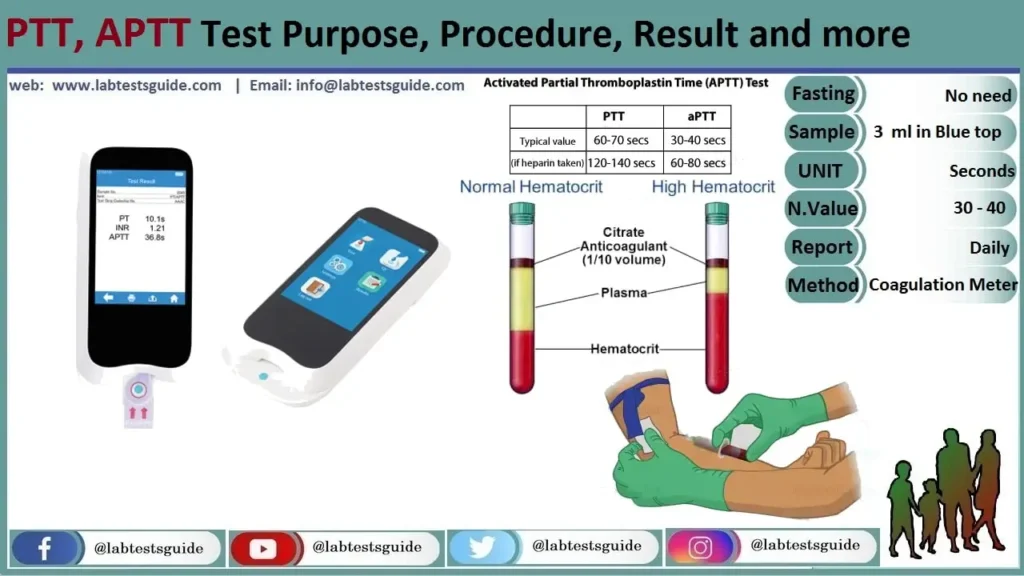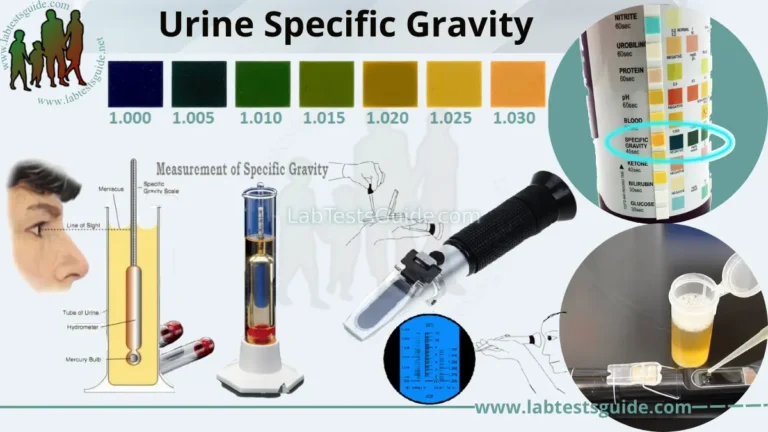PTT, which stands for Partial Thromboplastin Time, is a laboratory test that measures the time it takes for blood plasma to clot. It is primarily used to assess the functioning of the intrinsic pathway of the coagulation cascade.

| Also Known as | PTT, APTT, Partial Thromboplastin Time, Activated Partial Thromboplastin Time, |
| Test Purpose | measures the number of seconds it takes for a clot to form in a sample |
| Test Preparations | No Need but Overnight Fasting Is Preferred |
| Test Components | APTT, PTT |
| Specimen | 3 ML Whole Blood In 1 Blue Top (Sodium Citrate) Tube. Mix Thoroughly By Inversion. |
| Stability Room | 2 hours |
| Stability Refrigerated | 4 hours |
| Stability Frozen | 2 weeks |
| Method | Photo-Optical Clot Detection |
| Download Report | Download Report |
Definations:
PTT:
PTT, which stands for Partial Thromboplastin Time, is a laboratory test used to evaluate the intrinsic pathway of the coagulation cascade. It measures the time it takes for blood plasma to clot after the addition of a phospholipid-based reagent.
APTT:
APTT, which stands for Activated Partial Thromboplastin Time, is a laboratory test used to evaluate the intrinsic pathway of the coagulation cascade after activation with a specific activator. It measures the time it takes for blood plasma to clot after the addition of an activator, such as kaolin or ellagic acid.
Purpose of the test (Indications)
- This is used for the diagnosis of bleeding disorders.
- APTT may be used in the patient to check treatment who are taking Heparin or other blood-thinning medicines.
- APTT measures the intrinsic system and common pathways.
- APTT detects the functioning of factors XII, XI, X, IX, VII, V, II, and I (12, 11, 10, 9, 7, 2, 1).
- For the diagnosis of Hemophilia and Christmas disease.
Why get Tested:
Your doctor might order this test to check for a bleeding disorder, such as hemophilia or von Willebrand disease. Symptoms of bleeding disorders include:
- Bleeding or bruising easily
- Blood clots that form when they shouldn’t
- Blood in your poop or urine
- Gums that bleed easily
- Heavy menstrual periods in women.
- nosebleeds
- Swelling or pain in the joints
When To Get Tested?
When you have unexplained bleeding, inappropriate blood clotting, or recurrent miscarriages; sometimes when you are on standard heparin anticoagulant therapy; sometimes before a scheduled surgery
Sample Required:
- The blood is collected in an anticoagulant with a fixed ratio carefully.
- Take 0.2 ml anticoagulant (ESR solution may be used) and 1.8 ml whole blood.
- The APTT sample may be taken 30 to 60 min before the next dose of Heparin.
Precaution for sample
- Plasma is stable for one hour at 4 °C and 28 days if frozen.
- Sample handling is very critical. If the ratio of blood and anticoagulant is not correct, then the results are false and raised.
Normal Values:
Source 1
- Varies with the lab to lab.
- Normal control is always run with the patient sample.
- In general, is <35 seconds.
- PTT: 60 to 70 seconds.
- APTT: 30 to 40 seconds.
- If APTT is less than 50 seconds then the therapeutic goal is not achieved and the dose of Heparin may be increased.
- When APTT is greater than 100 seconds is risky for the patient and there are chances for spontaneous bleeding.
- Panic value Usually it is considered above 70 seconds.
- Heparin effect is immediate and short-lived as compared to warfarin.
Source 2
- APTT = 30 to 40 seconds
- PTT = 60 to 70 seconds
- Possible critical values
- APTT = >70 seconds
- PTT = > 100 seconds
Abnormal High Results Are Due To:
- All congenital deficiencies of Intrinsic system coagulation factors.
- Cirrhosis.
- Disseminated intravascular coagulopathy (DIC ).
- Factor XII deficiency.
- Hemophilia A and B.
- Hypofibrinogenemia.
- Malabsorption.
- Von Willebrand’s disease.
- Vit K deficiency.
- Fibrin breakdown products.
- Leukemia.
- Drugs.
Table of Differences Between PTT and APTT:
| PTT (Partial Thromboplastin Time) | APTT (Activated Partial Thromboplastin Time) |
|---|---|
| Measures the time it takes for blood to clot through the intrinsic pathway of coagulation. | Measures the time it takes for blood to clot through the intrinsic pathway of coagulation after activation with a specific activator. |
| Involves the addition of a phospholipid-based reagent to initiate the coagulation process. | Involves the addition of an activator, such as kaolin or ellagic acid, to initiate the coagulation process. |
| Typically used to monitor heparin therapy, as heparin affects the intrinsic pathway. | Typically used to monitor heparin therapy, as heparin affects the intrinsic pathway. |
| Used to evaluate bleeding disorders, such as hemophilia or von Willebrand disease. | Used to evaluate bleeding disorders, such as hemophilia or von Willebrand disease. |
| Results are reported in seconds. | Results are reported in seconds. |
| Normal range varies depending on the laboratory and reagents used, typically around 25-35 seconds. | Normal range varies depending on the laboratory and reagents used, typically around 25-35 seconds. |
| Prolonged PTT may indicate a clotting factor deficiency or presence of an inhibitor. | Prolonged APTT may indicate a clotting factor deficiency or presence of an inhibitor. |
| May be influenced by various factors such as lupus anticoagulant or specific factor deficiencies. | May be influenced by various factors such as lupus anticoagulant or specific factor deficiencies. |
| Can be used to screen for a variety of clotting disorders. | Can be used to screen for a variety of clotting disorders. |
| Can be affected by sample handling and pre-analytical variables. | Can be affected by sample handling and pre-analytical variables. |
Table of Similarities Between PTT and APTT:
| PTT (Partial Thromboplastin Time) | APTT (Activated Partial Thromboplastin Time) |
|---|---|
| Both are laboratory tests used to assess the intrinsic pathway of the coagulation cascade. | Both are laboratory tests used to assess the intrinsic pathway of the coagulation cascade. |
| Both involve the measurement of the time it takes for blood to clot. | Both involve the measurement of the time it takes for blood to clot. |
| Both assess the functionality of factors involved in the intrinsic pathway, including clotting factors VIII, IX, XI, and XII. | Both assess the functionality of factors involved in the intrinsic pathway, including clotting factors VIII, IX, XI, and XII. |
| Both can be used to evaluate and monitor bleeding disorders, such as hemophilia or von Willebrand disease. | Both can be used to evaluate and monitor bleeding disorders, such as hemophilia or von Willebrand disease. |
| Both can be prolonged in the presence of clotting factor deficiencies or inhibitors. | Both can be prolonged in the presence of clotting factor deficiencies or inhibitors. |
| Both are typically reported in seconds. | Both are typically reported in seconds. |
| Normal range can vary depending on the laboratory and reagents used, typically around 25-35 seconds. | Normal range can vary depending on the laboratory and reagents used, typically around 25-35 seconds. |
| Both may be influenced by factors such as lupus anticoagulant or specific factor deficiencies. | Both may be influenced by factors such as lupus anticoagulant or specific factor deficiencies. |
| Both can be used as screening tests for a variety of clotting disorders. | Both can be used as screening tests for a variety of clotting disorders. |
| Both can be affected by sample handling and pre-analytical variables. | Both can be affected by sample handling and pre-analytical variables. |
Possible References Used



